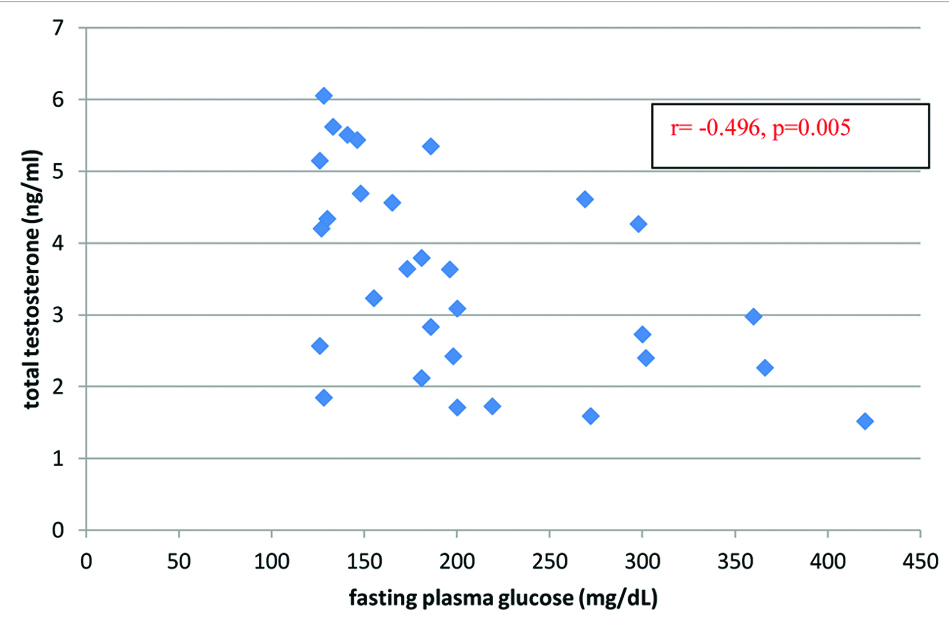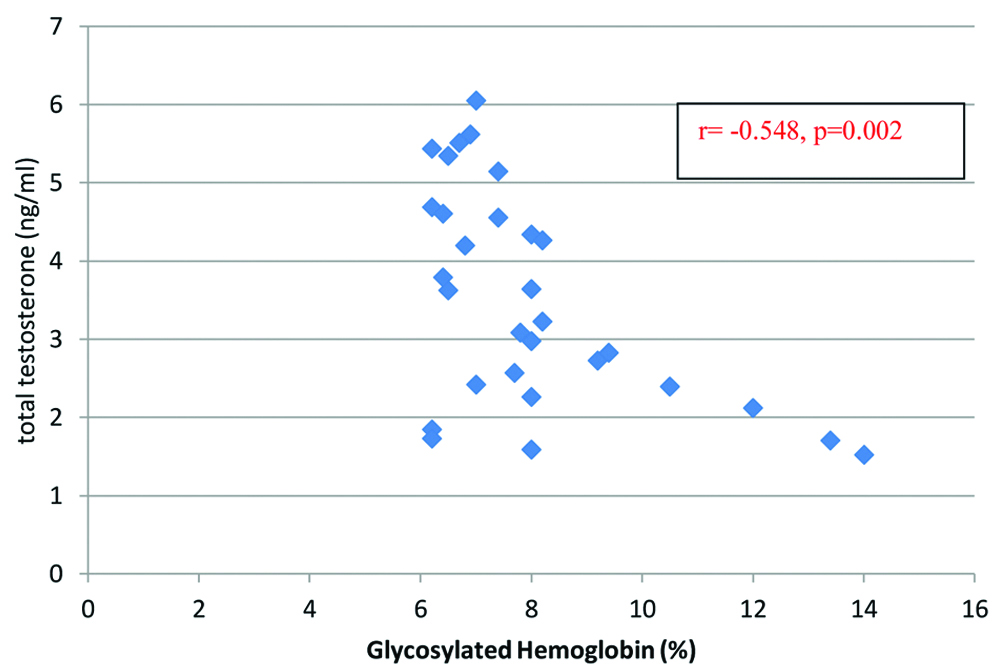Diabetes mellitus is a growing epidemic and most common endocrine disorder encountered in clinical practice. It is characterised by high levels of plasma glucose, due to either insulin insufficiency or insulin resistance [1].
Ding EL et al., study suggested role of testosterone in the sex-dependent aetiologies of T2DM in men [2]. Testosterone, a steroidal hormone of androgen group, secreted into the circulation by Leydig cells of testicles, help in the regulation of carbohydrate, protein, lipid metabolism and releases inflammatory cytokines like IL-6 and TNF-α, that are known to influence insulin sensitivity and have been shown to suppress secretion of hypothalamic gonadotropin-releasing hormone in experimental animals [3].
Testosterone also helps in the regulation of expression of genes involved in insulin signalling and glucose uptake by increasing the expression of GLUT4 in the muscle cells and adipose tissue and thereby testosterone deficiency may decrease glucose transport and insulin resistance, which further leads to progression of T2DM [4,5]. On the contrary, some studies showed negative correlation between changes in insulin resistance and testosterone levels in T2DM men [6].
Various studies report higher prevalence of testosterone deficiency in diabetic men, but the exact mechanism of action remains debatable. Therefore, the present study was conducted to evaluate the association of serum testosterone levels and severity and risk of T2DM in men.
Materials and Methods
The observational case-control study was conducted from September 2016 to May 2017 in the Teerthanker Mahaveer Hospital, Moradabad, Uttar Pradesh, India. In the present study, a total of 60 (power of study 80% and Confidence Interval 95%) men were included. Pre-diagnosed 30 T2DM men with fasting plasma glucose be ≥126 mg/dL and HbA1c level ≥6.5 were selected. Equal number of age-matched (35-55 years) and pre-confirmed non-diabetic men from hospital staff were recruited as controls. Informed verbal consent was obtained from all the participants under study.
Patients with known history of hypogonadism, on exogenous testosterone therapy, suffering from cardiac diseases, renal failure, liver cirrhosis or AIDS were excluded from the study.
The procedures followed were in accordance with the ethical standards (IEC No.: CM/CRC/16/010) of the Teerthanker Mahaveer Medical College and Research Centre Committee on human experimentation (Institutional or Regional) and with the Helsinki Declaration of 1975, revised in 2000.
Sample Collection
After overnight fasting, 5 mL of venous blood was drawn under aseptic conditions from antecubital vein of all the diabetic patients and controls. EDTA vial were used for glycosylated haemoglobin (HbA1c) estimation, fluoride oxalate vial for FPG estimation and plain vial for serum total testosterone estimation. All the samples were processed on the day of collection.
Biochemical Analysis
Fasting plasma glucose was estimated by GOD-POD, end point method on Microlab semiautomatic analyser using ERBA glucose kit (Catalogue No.B121758) [7]. HbA1c was measured by particle enhanced immunoturbidimetric method on Cobas C501 automatic analyser of Roche’s diagnostics (Catalogue No.33536301) [8]. And serum testosterone was measured by Enzyme Linked Fluorescent Assay (ELFA) technique using fully automated VIDAS analyser of Biomerieux (Catalogue No.1006455510) [9,10].
Statistical Analysis
The data obtained were analysed using Statistical Package for Social Science (SPSS) version 16.0. The values were expressed as Mean±SD and assessed using Student’s t-test (independent and unpaired). Pearson’s correlation coefficient was used to determine the correlation between total testosterone, FPG and HbA1c. The p-value of <0.05 was considered as statistically significant, and p-value <0.001 as highly significant.
Results
Highly significant (p<0.001) differences were observed in serum total testosterone, FPG and HbA1c levels between diabetic and control group [Table/Fig-1]. Serum total testosterone is negatively correlated with FPG of diabetic patients (r value=-0.496, p=0.005) [Table/Fig-2]. Serum total testosterone is negatively correlated with HbA1c of diabetic patients (r=-0.548), (p=0.002) [Table/Fig-3]. No significant difference was found between serum total testosterone in diabetic group having FPG≤200 mg/dL and FPG>200 mg/dL; HbA1c≤6.5 and >6.5; duration of DM≤2 years and >2 years [Table/Fig-4].
Demographic and biochemical parameters of the participants under study.
| Parameters | Diabetic (n=30) Mean±SD | Control (n=30) Mean±SD | t-value | p-value |
|---|
| Age (years) | 46.20±7.17 | 45.83±6.47 | 0.208 | 0.836 |
| Total testosterone (ng/mL) | 3.53±1.38 | 5.81±2.42 | 4.480 | ≤0.001** |
| FPG (mg/dL) | 205.33±81.21 | 85.10±14.38 | 7.985 | ≤0.001** |
| HbA1c | 8.01±2.03 | 4.64±0.52 | 8.763 | ≤0.001** |
Student’s t-test, *p<0.05 statistically significant, **p<0.001 highly significant
Correlation of FPG with serum total testosterone among diabetic patients (n=30).

Correlation of HbA1c with serum total testosterone among diabetic patients (n=30).

Association of serum total testosterone with FPG level (≤ 200 mg/dL and >200 mg/dL), HbA1c (≤6.5 and >6.5) and duration of diabetes mellitus (≤2 years and >2 years) in diabetic patients.
| Parameter | Total Testosterone (ng/mL) | t-value | p-value |
|---|
| FPG ≤200 mg/dL | 3.75±1.33 | 1.332 | 0.194 |
| FPG >200 mg/dL | 3.02±1.45 |
| HbA1c ≤6.5 | 3.89±1.44 | 0.848 | 0.403 |
| HbA1c >6.5 | 3.40±1.37 |
| Duration of DM ≤2 years | 3.53±1.32 | 0.008 | 0.994 |
| Duration of DM >2 years | 3.53±1.49 |
Student’s t-test, *p<0.05 statistically significant, **p<0.001 highly significant
Discussion
Testosterone is the most important gonadal hormone that regulates various physiological functions of the body. In recent years, androgen deficiency has been found to be associated with certain common systemic disorders like abdominal obesity and T2DM. Therefore, main objective of the study was to determine the role of testosterone in prognosis of T2DM.
In present study, serum total testosterone was found to be inversely correlated with FBS in diabetic patients (r-value -0.496), (p=0.005) indicating that lower serum total testosterone often leads to hyperglycaemia. Testosterone may affect insulin resistance through changes in body composition as testosterone deficiency may promote accumulation of visceral fat leading to increased secretion of proinflammatory cytokines, estradiol, leptin and ghrelin, that inhibit the action of Hypothalamic-Pituitary-Testicular (HPT) axis and thereby regulates insulin sensitivity and may promote hyperglycaemia [3].
This finding was similar to that of Abate N et al., study [11]. However, study conducted by Menendez E et al., reports the inverse correlation between serum total testosterone and glucose tolerance and diabetes mellitus [12]. In addition, study conducted by Corrales JJ et al., concluded that the testosterone supplementation therapy improves glycaemic status of diabetic patients [13]. Some studies concluded that men undergoing treatment with testosterone therapy, showed reduction in fat mass and gain in muscle mass and decreased glucose and insulin levels [14,15]. Therefore, suggesting a strong inverse correlation between fasting blood sugar and serum total testosterone levels.
In the present study, serum total testosterone was found to be negatively correlated with HbA1c in diabetic patients (r=-0.548), (p=0.002). These observations were similar to the findings of Zhang HY et al., [16]. On the contrary, Fukui M et al., reported positive correlation between total testosterone and HbA1c concentration [17]. Furthermore, the inverse association between serum total testosterone and HbA1c has been associated with the decreased stimulatory effect of testosterone on erythropoiesis (rate of formation of RBCs), this may lead to falsely decreased HbA1c. This finding might link its association with diabetes mellitus in hypogonadism [18]. In a study conducted by Heufelder AE et al., 32 hypogonadal T2DM men on testosterone therapy were given 50 mg testosterone gel once a day for around 52 weeks. As a result, significant reduction in HbA1c levels was observed along with improvement in of -0.8% (p<0.001) [18].
In the present study, the mean level of total testosterone levels of patients having FPG ≤200 mg/dL was apparently higher than total testosterone level of patients having FPG>200 mg/dL. However, the association was not found to be statistically significant (p=0.194). A study done by Ueshiba H, in Japanese population reported that the administration of testosterone improves FPG in men, hence improves insulin resistance [19].
The mean of total testosterone of patients having HbA1c ≤6.5 was apparently higher than total testosterone level of patients having HbA1c >6.5 but the association was statistically insignificant (p=0.403). These observations signify that serum total testosterone decreases with the increase in HbA1c levels. Similar results were reported by Zhang HY et al., [16]. Therefore, it can be concluded that HbA1c serves as an indicator of total testosterone, which reduces with the increase in severity of DM.
Lastly, in the present study, total testosterone levels in diabetic group of patients were further compared according to duration of diabetes (≤2 years and >2 years). However, significant association was observed (p=0.994). Comparable mean values of serum total testosterone obtained in the two groups indicate that serum total testosterone might be independent of duration of DM. These observations were found to be different from the study done by Al Hayek S et al., which reported that prevalence of low serum testosterone levels were higher with a longer duration of diabetes mellitus [20]. The present findings were similar to Ganesh HK et al., study, where no association between total testosterone and duration of diabetes mellitus was observed [21].
Based on the available literature and results of the present study, it can be deduced that the serum total testosterone affects the pathogenesis of T2DM.
Limitation
The sample size was relatively small. Further research with a larger sample is needed to validate our findings. Also, further studies are required to establish the role of testosterone replacement therapy in improving the glycaemic status of male patients with type 2 diabetes mellitus.
Conclusion
This study suggests that lowered testosterone level can significantly increase the risk of T2DM in men. Variations in the serum testosterone levels can be used as a biomarker for assessment of progression of T2DM. In addition, testosterone supplementation should be considered to improve clinical outcomes among T2DM men.
Student’s t-test, *p<0.05 statistically significant, **p<0.001 highly significantStudent’s t-test, *p<0.05 statistically significant, **p<0.001 highly significant